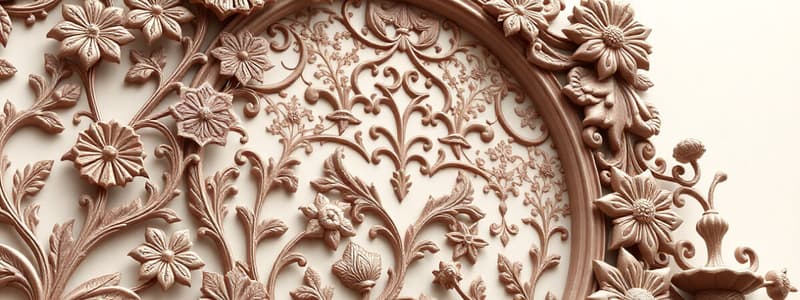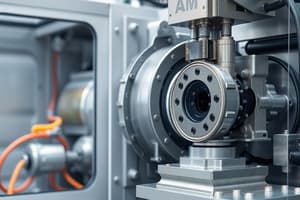Podcast
Questions and Answers
What is a primary focus of architectural modeling in reverse engineering data?
What is a primary focus of architectural modeling in reverse engineering data?
- Modifying designs to display textures and colors (correct)
- Using only the STL file format for designs
- Eliminating layers in the printing process
- Creating accurate replicas of existing structures
Color and multiple material systems will likely decrease in prevalence within additive manufacturing technologies in the future.
Color and multiple material systems will likely decrease in prevalence within additive manufacturing technologies in the future.
False (B)
What is one potential advancement in additive manufacturing processes mentioned?
What is one potential advancement in additive manufacturing processes mentioned?
The commercialization of hybrid technologies combining additive and subtractive processes.
As direct digital manufacturing becomes more common, there will be a need to develop standardized software processes based around _______.
As direct digital manufacturing becomes more common, there will be a need to develop standardized software processes based around _______.
Match the following technologies with their descriptions:
Match the following technologies with their descriptions:
Which layer thickness is typical for most FDM Dimension machines?
Which layer thickness is typical for most FDM Dimension machines?
Fine details in a design can be problematic for some AM technologies.
Fine details in a design can be problematic for some AM technologies.
What is a key advantage of using photopolymer-based systems?
What is a key advantage of using photopolymer-based systems?
In powder-based systems, there is no need to use __________.
In powder-based systems, there is no need to use __________.
Match the following systems with their characteristics:
Match the following systems with their characteristics:
Which of the following is NOT a characteristic of powder-based systems?
Which of the following is NOT a characteristic of powder-based systems?
What is often required during the support removal process in additive manufacturing?
What is often required during the support removal process in additive manufacturing?
Newer resins in photopolymer systems do not degrade rapidly if UV protective coatings are applied.
Newer resins in photopolymer systems do not degrade rapidly if UV protective coatings are applied.
Additive manufacturing parts typically behave according to standard material specifications of conventional methods.
Additive manufacturing parts typically behave according to standard material specifications of conventional methods.
What must be considered during post-processing that involves heat?
What must be considered during post-processing that involves heat?
What type of finishing may be involved in the post-processing stage of additive manufacturing?
What type of finishing may be involved in the post-processing stage of additive manufacturing?
AM machines often create parts with small voids or _____ trapped inside them.
AM machines often create parts with small voids or _____ trapped inside them.
What is a key characteristic of droplet-based systems like the Thermojet process?
What is a key characteristic of droplet-based systems like the Thermojet process?
Match the following stages of additive manufacturing with their descriptions:
Match the following stages of additive manufacturing with their descriptions:
Solid sheets used in lamination methods eliminate the need for waste material processing.
Solid sheets used in lamination methods eliminate the need for waste material processing.
What is a common characteristic of materials produced through additive manufacturing?
What is a common characteristic of materials produced through additive manufacturing?
Which of the following is a common action required before building a part?
Which of the following is a common action required before building a part?
Which of the following is a key step in the generalized additive manufacturing (AM) process chain?
Which of the following is a key step in the generalized additive manufacturing (AM) process chain?
All AM machines require the same setup parameters.
All AM machines require the same setup parameters.
List two factors to consider when comparing metal systems to polymer systems.
List two factors to consider when comparing metal systems to polymer systems.
All applications of additive manufacturing require high performance components.
All applications of additive manufacturing require high performance components.
What is typically required to prepare parts that need adjustments for material properties like shrinkage?
What is typically required to prepare parts that need adjustments for material properties like shrinkage?
What can be used in post-processing to assist with tasks like polishing?
What can be used in post-processing to assist with tasks like polishing?
The conversion to STL occurs automatically within most CAD systems.
The conversion to STL occurs automatically within most CAD systems.
Equipment maintenance is crucial when using ____ or printer technology.
Equipment maintenance is crucial when using ____ or printer technology.
What does STL stand for in the context of additive manufacturing?
What does STL stand for in the context of additive manufacturing?
Match the following application areas with their corresponding technologies:
Match the following application areas with their corresponding technologies:
The process of building a part in additive manufacturing involves _____ based manufacturing.
The process of building a part in additive manufacturing involves _____ based manufacturing.
Match the following terms with their descriptions:
Match the following terms with their descriptions:
The eight steps in additive manufacturing include conceptualization, CAD, conversion to ______, and machine setup.
The eight steps in additive manufacturing include conceptualization, CAD, conversion to ______, and machine setup.
Which of the following is NOT a consideration for designing for additive manufacturing (AM)?
Which of the following is NOT a consideration for designing for additive manufacturing (AM)?
Interlocking features can aid in reducing part count in an assembly.
Interlocking features can aid in reducing part count in an assembly.
Match the following AM machine types with their characteristics:
Match the following AM machine types with their characteristics:
What happens if an incorrect setup procedure is performed on an AM machine?
What happens if an incorrect setup procedure is performed on an AM machine?
Exposure to ____ and excess light should be avoided due to material handling issues.
Exposure to ____ and excess light should be avoided due to material handling issues.
All machines will alert the user once the building process is complete.
All machines will alert the user once the building process is complete.
Which application area does NOT typically involve conventional CAD modeling?
Which application area does NOT typically involve conventional CAD modeling?
Part orientation is not important in the design for additive manufacturing.
Part orientation is not important in the design for additive manufacturing.
What is commonly required after parts are built in an AM machine before they are ready for use?
What is commonly required after parts are built in an AM machine before they are ready for use?
Name one issue related to materials handling in additive manufacturing.
Name one issue related to materials handling in additive manufacturing.
Which method is primarily used for photomasks in the microelectronic industry?
Which method is primarily used for photomasks in the microelectronic industry?
In the vector scan approach, recoating is unnecessary.
In the vector scan approach, recoating is unnecessary.
What type of light is predominantly used in dentistry?
What type of light is predominantly used in dentistry?
The ___ projection approach utilizes a large radiation beam patterned by a Digital Micromirror Device.
The ___ projection approach utilizes a large radiation beam patterned by a Digital Micromirror Device.
Match the configurations used in photopolymerization processes with their descriptions:
Match the configurations used in photopolymerization processes with their descriptions:
Which of the following is a key component of photopolymerization processes?
Which of the following is a key component of photopolymerization processes?
What type of radiation is primarily used to cure most photopolymers?
What type of radiation is primarily used to cure most photopolymers?
Two-Photon Vat Photopolymerization offers multiple benefits and no drawbacks.
Two-Photon Vat Photopolymerization offers multiple benefits and no drawbacks.
Photopolymers were developed in the 1970s and are used in the printing industry.
Photopolymers were developed in the 1970s and are used in the printing industry.
What is the purpose of modeling in photopolymerization processes?
What is the purpose of modeling in photopolymerization processes?
Who experimented with UV curable materials and is credited with the beginning of stereolithography (SL) technology?
Who experimented with UV curable materials and is credited with the beginning of stereolithography (SL) technology?
The process of ______ involves exposing layers of liquid resin to UV light to create solid patterns.
The process of ______ involves exposing layers of liquid resin to UV light to create solid patterns.
In vector scan machines, different __________ patterns like WEAVE and STAR-WEAVE are used for building parts.
In vector scan machines, different __________ patterns like WEAVE and STAR-WEAVE are used for building parts.
Match the following photopolymerization processes with their characteristics:
Match the following photopolymerization processes with their characteristics:
Match the following photopolymerization technologies with their characteristics:
Match the following photopolymerization technologies with their characteristics:
What type of polymerization is associated with acrylate photopolymers?
What type of polymerization is associated with acrylate photopolymers?
The recoating system in Vector Scan VP Machines is responsible for lifting the platform after each layer is cured.
The recoating system in Vector Scan VP Machines is responsible for lifting the platform after each layer is cured.
Name one type of radiation commonly used to cure photopolymers.
Name one type of radiation commonly used to cure photopolymers.
The main purpose of a photoinitiator in photopolymerization is to convert ______ into reactive intermediates.
The main purpose of a photoinitiator in photopolymerization is to convert ______ into reactive intermediates.
Match the following photopolymerization types with their corresponding materials:
Match the following photopolymerization types with their corresponding materials:
What is typically done during the finishing phase after building a part using Laser Scan Vat Photopolymerization?
What is typically done during the finishing phase after building a part using Laser Scan Vat Photopolymerization?
Post-curing is the final step in the Laser Scan Vat Photopolymerization process.
Post-curing is the final step in the Laser Scan Vat Photopolymerization process.
What is the role of multifunctional monomers in photopolymer resin formulation?
What is the role of multifunctional monomers in photopolymer resin formulation?
What is one of the main advantages of vat photopolymerization technology over other Additive Manufacturing technologies?
What is one of the main advantages of vat photopolymerization technology over other Additive Manufacturing technologies?
Current SL materials possess impact strength and durability comparable to high-quality injection molded thermoplastics.
Current SL materials possess impact strength and durability comparable to high-quality injection molded thermoplastics.
What is the position accuracy in the x-y directions for the atypical point-wise Microsterolithography process?
What is the position accuracy in the x-y directions for the atypical point-wise Microsterolithography process?
The minimum size of the unit of hardened polymer is _______ in x, y, z dimensions.
The minimum size of the unit of hardened polymer is _______ in x, y, z dimensions.
Which of the following is a recognized drawback of using vat photopolymerization?
Which of the following is a recognized drawback of using vat photopolymerization?
Mask projection VP technologies have a speed disadvantage compared to laser scan SL.
Mask projection VP technologies have a speed disadvantage compared to laser scan SL.
What is the maximum size of the fabrication structure achievable through the atypical point-wise Microsterolithography process?
What is the maximum size of the fabrication structure achievable through the atypical point-wise Microsterolithography process?
Flashcards
STL File Segmentation
STL File Segmentation
Dividing a complex 3D model into smaller, simpler parts for easier 3D printing.
Shrinkage Allowance
Shrinkage Allowance
Adjusting the size of a 3D model during design to compensate for material shrinkage during the 3D printing process.
Coating Allowances
Coating Allowances
Adding extra material to a 3D model during design to account for the thickness of a coating that will be applied after printing.
AM Machine Setup Parameters
AM Machine Setup Parameters
Signup and view all the flashcards
Semi-Automated Build Stages
Semi-Automated Build Stages
Signup and view all the flashcards
Computer-Controlled Build Phase
Computer-Controlled Build Phase
Signup and view all the flashcards
Layer Control
Layer Control
Signup and view all the flashcards
Removal and Cleanup
Removal and Cleanup
Signup and view all the flashcards
Support Structures in AM
Support Structures in AM
Signup and view all the flashcards
Support Removal
Support Removal
Signup and view all the flashcards
Post-processing in AM
Post-processing in AM
Signup and view all the flashcards
Application-Specific Post-processing
Application-Specific Post-processing
Signup and view all the flashcards
AM Materials Properties
AM Materials Properties
Signup and view all the flashcards
Anisotropic Properties
Anisotropic Properties
Signup and view all the flashcards
AM Material Improvements
AM Material Improvements
Signup and view all the flashcards
Growing Applications of AM
Growing Applications of AM
Signup and view all the flashcards
Reverse Engineering Data
Reverse Engineering Data
Signup and view all the flashcards
Laser Scanning Technology
Laser Scanning Technology
Signup and view all the flashcards
Architectural Modeling
Architectural Modeling
Signup and view all the flashcards
STL file format
STL file format
Signup and view all the flashcards
Hybrid Technologies in AM
Hybrid Technologies in AM
Signup and view all the flashcards
Generalized AM Process Chain
Generalized AM Process Chain
Signup and view all the flashcards
STL File
STL File
Signup and view all the flashcards
What are the 8 steps of the AM process?
What are the 8 steps of the AM process?
Signup and view all the flashcards
Machine Setup
Machine Setup
Signup and view all the flashcards
Post-Processing
Post-Processing
Signup and view all the flashcards
Design for AM
Design for AM
Signup and view all the flashcards
Part Removal and Cleanup
Part Removal and Cleanup
Signup and view all the flashcards
Application Areas of AM
Application Areas of AM
Signup and view all the flashcards
Support Structure
Support Structure
Signup and view all the flashcards
Droplet-Based Systems
Droplet-Based Systems
Signup and view all the flashcards
Extrusion Process
Extrusion Process
Signup and view all the flashcards
Lamination Methods (Support)
Lamination Methods (Support)
Signup and view all the flashcards
Material Waste Management
Material Waste Management
Signup and view all the flashcards
Metal Systems in AM
Metal Systems in AM
Signup and view all the flashcards
Equipment Maintenance (AM)
Equipment Maintenance (AM)
Signup and view all the flashcards
What is a common layer thickness in AM?
What is a common layer thickness in AM?
Signup and view all the flashcards
How does layer thickness affect part build time?
How does layer thickness affect part build time?
Signup and view all the flashcards
What is the challenge with fine details in AM?
What is the challenge with fine details in AM?
Signup and view all the flashcards
How does material choice affect AM process?
How does material choice affect AM process?
Signup and view all the flashcards
What are key considerations for post-processing?
What are key considerations for post-processing?
Signup and view all the flashcards
Describe the difference between powder-based AM and photopolymer-based AM.
Describe the difference between powder-based AM and photopolymer-based AM.
Signup and view all the flashcards
What is a unique feature of Zcorp. parts?
What is a unique feature of Zcorp. parts?
Signup and view all the flashcards
What are the advantages and disadvantages of photopolymer-based AM?
What are the advantages and disadvantages of photopolymer-based AM?
Signup and view all the flashcards
Photopolymerization
Photopolymerization
Signup and view all the flashcards
UV Light
UV Light
Signup and view all the flashcards
How photopolymer resin is used
How photopolymer resin is used
Signup and view all the flashcards
What is SL Technology?
What is SL Technology?
Signup and view all the flashcards
Why is photopolymer important for coating & printing?
Why is photopolymer important for coating & printing?
Signup and view all the flashcards
Vat Photopolymerization
Vat Photopolymerization
Signup and view all the flashcards
Photopolymer Chemistry
Photopolymer Chemistry
Signup and view all the flashcards
Photoinitiator System
Photoinitiator System
Signup and view all the flashcards
Interpenetrating Polymer Network (IPN)
Interpenetrating Polymer Network (IPN)
Signup and view all the flashcards
Laser Scan Vat Photopolymerization
Laser Scan Vat Photopolymerization
Signup and view all the flashcards
What are the common radiation sources in Stereolithography (SL)?
What are the common radiation sources in Stereolithography (SL)?
Signup and view all the flashcards
What are the main configurations for photopolymerization processes?
What are the main configurations for photopolymerization processes?
Signup and view all the flashcards
Digital Micromirror Device (DMD)
Digital Micromirror Device (DMD)
Signup and view all the flashcards
Two-Photon Polymerization
Two-Photon Polymerization
Signup and view all the flashcards
Advantages of avoiding recoating
Advantages of avoiding recoating
Signup and view all the flashcards
UV Curable Photopolymers
UV Curable Photopolymers
Signup and view all the flashcards
Free Radical Polymerization
Free Radical Polymerization
Signup and view all the flashcards
Cationic Polymerization
Cationic Polymerization
Signup and view all the flashcards
Laser Scan VP
Laser Scan VP
Signup and view all the flashcards
Recoating System
Recoating System
Signup and view all the flashcards
Platform System
Platform System
Signup and view all the flashcards
Vat System
Vat System
Signup and view all the flashcards
Discretization in Layered Manufacturing
Discretization in Layered Manufacturing
Signup and view all the flashcards
ACES Scan Pattern
ACES Scan Pattern
Signup and view all the flashcards
Micro-Vat Photopolymerization
Micro-Vat Photopolymerization
Signup and view all the flashcards
Mask Projection VP
Mask Projection VP
Signup and view all the flashcards
Accuracy in SLA
Accuracy in SLA
Signup and view all the flashcards
Surface Finish in SLA
Surface Finish in SLA
Signup and view all the flashcards
Advantages of Vat Photopolymerization
Advantages of Vat Photopolymerization
Signup and view all the flashcards
Drawbacks of Vat Photopolymerization
Drawbacks of Vat Photopolymerization
Signup and view all the flashcards
Study Notes
Generalized Additive Manufacturing Process Chain
- Additive Manufacturing (AM) is a process with key steps
- Steps include conceptualization and CAD, conversion to STL, transfer and manipulation of STL files on AM machines
- Machine setup, build, part removal and cleanup, post-processing, and application are also involved
- Variations can occur between different AM machines, influenced by photopolymer, powder-based, and molten material systems. Metal-based systems have variations as well
- Material properties, including the use of substrates, energy density, weight, accuracy and speed, as well as maintenance of machine equipment and material handling are all important factors in the process
- Design for AM includes part orientation, support removal, hollowing out parts, including undercuts, reducing part count in an assembly, and using identification markings/numbers
Eight Steps in AM
- Conceptualization and CAD: Product design and function are visualized, often through various methods like textual descriptions, sketches, or 3D CAD models.
- Conversion to STL: CAD models are converted to STL (Stereolithography) files, which describe the model's geometry using triangular facets. This conversion is automatic in most CAD systems.
- Transfer to AM Machine and STL File Manipulation: STL files are sent to the target machine. Verification, repositioning, or adjustments to accommodate machine tolerances might be needed. This step may involve verification that the part is correct, use of visualization tools for manipulation, repositioning of the part or changing the orientation, and managing multiple parts for a single machine process. Parts may require shrinkage or coating allowance during this phase.
- Machine Setup: Specific parameters for each AM machine or process are considered, like materials, layer thickness, build parameters. Incorrect settings may affect the part quality. Multiple materials, a variety of layer thickness, and optimization options are common in machine setups, and may require special considerations
- Build: Mostly semi-automated, with considerable manual control and decision-making involved. Layers are controlled, built, and formed one after the other, combining material deposition. Different approaches are used by different machines
- Removal and Cleanup: Parts are separated from the build platform or excess build material. Support structure removal might be needed for some designs. Manual finishing is often necessary after this step, including support structure removal.
- Post-processing: This involves finishing the part for specific applications, using techniques like abrasive finishing, polishing, or coating applications. Specific requirements, like precision, depend on the application. Finishing procedures also may include tubs/ovens for specific materials.
- Application: After post-processing, parts are ready for use, but characteristics may not always perfectly align with standard material specifications. Possible issues include material degradation, trapped bubbles/materials within parts, anisotropic properties of the material
- Parts may not always behave according to material standards in subsequent use, such as molding or casting;
- AM machines may create parts with small voids or bubbles trapped inside. This could be the source of part failure under mechanical stress
- Some AM processes cause material degradation during build and not to be properly bonded, linked, or crystallized;
- This can lead to anisotropic (different properties in different directions) properties.
- AM materials and processes are improving, and many applications may not require high performance
- The number of applications for AM processes are continually increasing
Variations from One AM Machine to Another
- Photopolymer-Based Systems: Easy setup, but less robust materials, and supports can come off easily. Supports can be the same material as the part
- Powder-Based Systems: Don't need supports; usually easy setup; parts can be colored using colored binder materials
- Molten Material Systems: These systems use support structures, which are generated automatically, sometimes with user flexibility;
- Solid Sheets: These systems don't need supports(lamination); waste material and cleanup might be more laborious; bonding of polymer sheets is often reliable
Material Considerations
- Metal Systems: Considerations include the use of substrates, energy density, weight, accuracy, and speed.
- Maintenance of Equipment: Requires careful monitoring and protection from noise or dirt, as well as electrical noise and mechanical vibration
- Material Handling: Exposure to moisture, excess light should be avoided. Materials might be loaded or unloaded offline using software systems, and recycling might be required
- Design for AM: Important design aspects for AM include part orientation, handling built-up parts, removal of supports, and features(undercuts). Reducing the parts/assembly count is also helpful
- Design Consideration in AM - Considerations like interlocking features are necessary for certain parts designs
Application Considerations
- AM applications might not align with standard material specifications
- Issues like trapped material, material degradation, or the anisotropic properties of materials might occur. However, AM applications are expanding rapidly
Exercises
- Investigate websites for AM technologies, focusing on each step of the process and any particular tasks
- Surface models are unsuitable for AM parts, due to the need for accurate geometric representation for creation. Problems like inappropriate resolutions are possible
- VRML is more suitable than STL for certain applications (e.g., color) for ZCorp printing
- Consider additional factors (e.g., material properties, design constraints) when creating medical models using AM
- Explore finishing methods for different material parts (for example, color ZCorp)
Studying That Suits You
Use AI to generate personalized quizzes and flashcards to suit your learning preferences.




